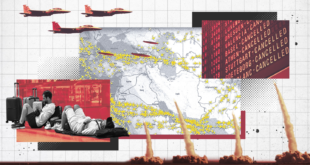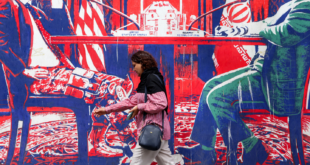 TEHRAN (FNA)- Iran has threatened to call off talks with Ashok Leyland Project Services Ltd and sign a contract with a Chinese firm to build a rail link in that country due to differences with the Indian infrastructure company over execution of the project.
TEHRAN (FNA)- Iran has threatened to call off talks with Ashok Leyland Project Services Ltd and sign a contract with a Chinese firm to build a rail link in that country due to differences with the Indian infrastructure company over execution of the project.
Iran had signed an agreement with a consortium led by Ashok Leyland Project Services, a unit of Ashok Leyland Ltd, the flagship company of the Hinduja Group, for the construction of the 708km Chabahar-Fahraj railway link.
The other members of the consortium for the €1.1 billion rail project include Ircon and RITES Ltd, both subsidiaries of the Indian Railways.
While the consortium favors constructing the project on the build, lease and transfer (BLT) model, the Railway Company of Islamic Republic of Iran wants it to be executed on the build, operate and transfer (BOT) model, said an Iranian government official in the ministry of roads and transportation in New Delhi.
“There is a Chinese company vying for the project. If we cannot solve the problem, we will sign the contract with it. As it is a very important project for our country, we cannot wait for such a long time,” he said asking not be named.
The source also declined to name the Chinese company.
In the BOT model, projects are owned by developers who enjoy rights to earn revenue from an asset over a specified period. In the BLT model, the contractor is paid a fixed amount to build the project by the client, usually in installments.
A spokesperson at Ashok Leyland declined comment.
This is not the first time that a railway project involving Indian firms in Iran has hit a road block. Some other Iran projects of Rites have already hit the skids over a dispute over how they would be executed as reported by Mint on 4 November.
Iran has only 6,000km railway network. The Chabahar-Fahraj railway link aims to connect the country’s railway network to the ocean port of Chabahar. The traffic forecast studies show the line carrying 1.4 million tons of freight and 300,000 passengers in the first year of operations in 2014. Cargo and passenger traffic are expected to go up by 186% and 67%, respectively, by 2026.
“In the oil sector too, China has beaten us (in) most of the projects. This is happening because it has the proactive support of the government in pursuing contracts (overseas). They do it with (the country’s) strategic interest (in mind) as well…we still see these projects as commercial,” said Harsh Srivastava, vice-president of infrastructure consultant Feedback Ventures.
The $7.4 billion Iran-Pakistan-India pipeline project is waiting for India’s final answer, although Iran has underlined that it would move ahead with or without India. Indian Minister of external affairs Pranab Mukherjee was recently in Tehran to co-chair the India-Iran joint commission, which promotes bilateral cooperation.
Iran and Pakistan initiated a Gas Sales Purchase Agreement earlier this year. Indian and Pakistani officials also announced earlier this year that they had resolved almost all bilateral issues including transit fee which saw New Delhi boycotting IPI pipeline talks for about a year.
India has more or less agreed to give Pakistan a transit fee of $200 million per year, which is equivalent to $0.60 per million British thermal unit for allowing passage of the pipeline through that country.
India and Pakistan finally agreed in February 2007 to pay Iran $4.93 per million British thermal units ($4.67/GJ) but some details relating to price adjustment remained open to further negotiation. There was a breakthrough in the talks in April 2008 when Iranian President Mahmoud Ahmadinejad visited Pakistan and India.
According to the project proposal, the pipeline will begin from Iran’s Assalouyeh Energy Zone in the south and stretch over 1,100 km through Iran. In Pakistan, it will pass through Baluchistan and Sindh but officials now say the route may be changed if China agrees to the project.
The gas will be supplied from the South Pars field. The initial capacity of the pipeline will be 22 billion cubic meter of natural gas per annum, which is expected to be later raised to 55 billion cubic meter. It is expected to cost $7.4 billion.
According to Indian ministry sources, the IPI gas pipeline is quite crucial for New Delhi as after signing of the agreement, 60 million standard cubic meters per day (mmscmd) of gas is expected to be supplied in phase-I, which will be shared equally between India and Pakistan.
In phase-II, 90 mmscmd of gas will be supplied to India and Pakistan. So far six meetings of the trilateral joint working group (JWG) of the participating countries have been held with the last meeting being held in New Delhi on June 28-29, 2007.
India, Asia’s third-largest economy, can produce only half the gas it needs to generate electricity, causing blackouts and curbing economic growth. Demand may more than double to 400 million cubic meters a day by 2025 if the economy grows at the projected rate of 7 to 8 percent a year, according to the Indian oil ministry.
Iran plans to start exporting gas to Pakistan in 2011. Iran has completed half the pipeline, which can carry 110 million cubic meters of gas a day, National Iranian Gas Company (NIOC) said in April. India uses about 108 million cubic meters of gas a day, according to a BP Plc report.
 Eurasia Press & News
Eurasia Press & News


